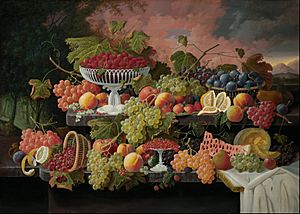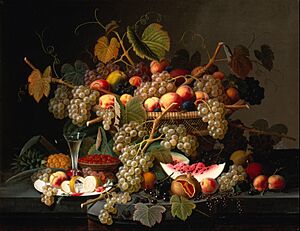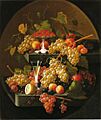Severin Roesen facts for kids
Severin Roesen (born around 1815 in Boppard, died around 1872) was a painter from Prussia who later became an American citizen. He is famous for his many paintings of fruit and flowers, known as still lifes. Today, he is seen as one of the most important American still life painters of the 1800s.
Contents
Severin Roesen's Early Life

Severin Roesen was born in 1815 in Boppard, which was then part of Prussia (now Germany). He was baptized on February 5, 1816. We don't know much about his childhood or how he was educated.
On March 10, 1847, he married Sophia Jacobina Lambricht in Koblenz, Rhineland. At this time, he worked as a porcelain painter in Cologne. He even showed a flower painting at a local art club there in 1847.
Moving to America
Severin and Sophia traveled to Dover, England, arriving on December 27, 1847. From there, they moved to New York, arriving on February 4, 1848. Sadly, Sophia died soon after they reached America.
On October 30, 1849, Roesen married Wilhelmine Ludwig. She was born in 1831 in Alzey, Prussia. They had three children together: Minnie (born 1854), Oscar (born 1857), and another child whose name and birth date are not known.
The family lived in New York City. Roesen sold his paintings to people and to the American Art-Union. He also taught others how to paint still life pictures to support his family.
Life in Pennsylvania
In 1857, Roesen left his family and moved to Pennsylvania. He lived for a short time in Philadelphia. Then he moved to smaller, German-American towns like Harrisburg and Huntingdon.
Around 1863, he settled in Williamsport. During these years, his paintings were shown in different places. These included the Maryland Historical Society in Baltimore in 1858. His art was also displayed at the Pennsylvania Academy of the Fine Arts in 1863.
A newspaper in Williamsport, the Williamsport Sun and Banner, wrote about Roesen in 1895. They said his art studio was a popular place for his friends to visit. They would spend the day with him, enjoying his company.
Many of Roesen's paintings were found in Williamsport. The town was growing, and many people, especially those of German background, were becoming successful. They bought his paintings of nature's bounty for their new homes. They also bought them for local gathering places. One hotel owner, Jacob Flock, owned more than fifty of Roesen's paintings. It seems the artist traded his art for a place to stay.
Roesen's last painting with a date on it is from 1872. After this, there are no more records of his life. We do not know when or where he died.
Roesen's Artistic Style
More than 300 still life paintings by Severin Roesen have been found. However, only about 24 of them have a date on them.
Roesen's paintings show great care and detail. He used precise arrangements and careful brushwork. Interestingly, the things he painted, and even the small details, stayed much the same throughout his career. Sometimes, he made almost exact copies of his paintings. More often, he would simply rearrange the same items in new ways.
For example, many items in his painting Fruit and Wine Glass also appear in his other works. A dessert plate full of strawberries is a common sight. A pilsner glass, sometimes with an open bottle of champagne, is often seen. Sometimes, a wine goblet filled with lemonade is used instead. The glass is almost always placed on the lower left side of the painting. A halved lemon often appears close by.
Branches full of grapes are usually arranged from the lower left to the upper right. This creates a graceful S-shape in the painting. It helps guide your eye across the whole picture. The paintings often have light and dark grapes on each side. They are filled in with scattered raspberries, cherries, peaches, apples, pears, and apricots. Many of these ideas for arranging the items came from 1600s Dutch still life painters, like Jan van Huysum.
Images for kids
-
Still Life with Fruit, Brooklyn Museum of Art
-
Flower Still Life with Bird's Nest, Metropolitan Museum of Art
-
Still Life with a Basket of Fruit, Saint Louis Art Museum
-
Still Life With Fruit, in the White House
Further Reading
- Judith Hansen O'Toole: Severin Roesen, Lewisburg, Penn.: Bucknell University Press (1992)
- William H. Gerdts: Painters of the Humble Truth: Masterpieces of American Still Life, 1801-1939, Columbia and London: University of Missouri Press (1981)










